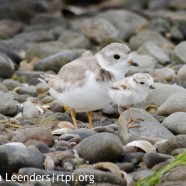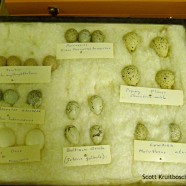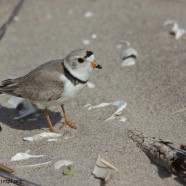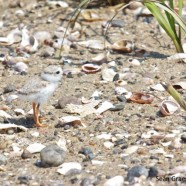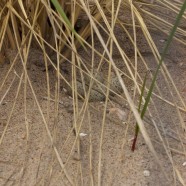Piping Plover (Charadrius melodus)
Heading to the shore this weekend? Please remember to share the beach with families of birds like these Piping Plover (Charadrius melodus). There is room for all of us to enjoy it if we respect their space.
Read MoreEggs from the archives
There are dozens of pairs of Piping Plovers and American Oystercatchers currently with nests or young hatchlings across the Connecticut coast. We are working seven days a week as a partner in the Audubon Alliance for Coastal Waterbirds to provide stewardship and survey efforts for these birds with seasonal staff members, Audubon Connecticut staff and our tremendous volunteers, numbering well over 100 dedicated people. Least and Common Terns are also beginning to nest, a bit later than usual this year likely because of low prey populations (and maybe cooler water because of the extremely cold...
Read MorePiping Plover (Charadrius melodus)
Piping Plovers are keeping our Audubon Alliance for Coastal Waterbirds staff very busy in Connecticut right now from birds not accepting exclosures, predator attacks and all the tiny hatchlings running around beaches. Caring for an endangered species 24/7 is tough but valuable and satisfying work.
Read MorePiping Plover hatchling (Charadrius melodus)
Over Memorial Day weekend Piping Plovers like this one by Sean started hatching across Connecticut. At the Audubon Alliance for Coastal Waterbirds we and our tremendous volunteers have our hands full now 24/7! The hectic summer breeding season has commenced.
Read MorePiping Plovers nesting at Griswold Point
Earlier this week RTPI Affiliate and Audubon Alliance for Coastal Waterbirds Technician Sean Graesser assisted the Connecticut Department of Energy and Environmental Protection (CT DEEP) in erecting Piping Plover exclosures at The Nature Conservancy’s Griswold Point property in Old Lyme, Connecticut. This is the third year that Sean is helping CT DEEP in this delicate process where a metal cage is set up around a complete four-egg Piping Plover clutch in order to prevent predators from being able to easily take the eggs. The exclosure, which can be seen in the second to last photo, has...
Read More



